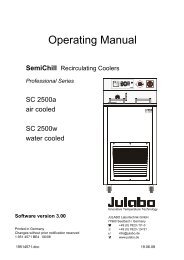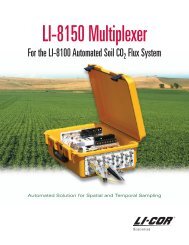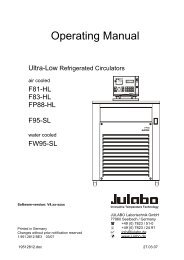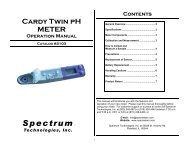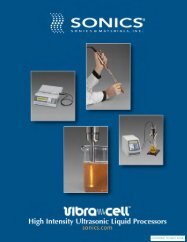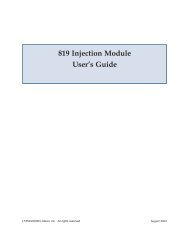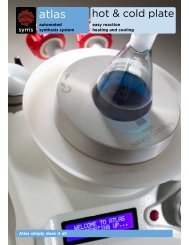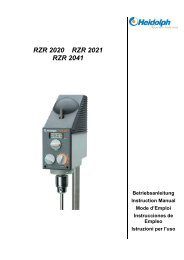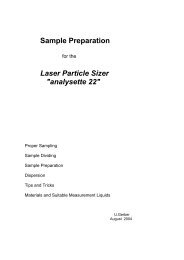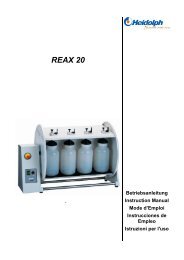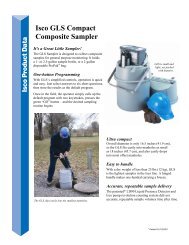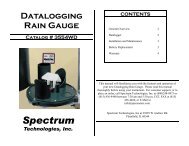Optical Dissolved-Oxygen - Measurement Specialties, Inc.
Optical Dissolved-Oxygen - Measurement Specialties, Inc.
Optical Dissolved-Oxygen - Measurement Specialties, Inc.
Create successful ePaper yourself
Turn your PDF publications into a flip-book with our unique Google optimized e-Paper software.
Eureka 2 <strong>Optical</strong> <strong>Dissolved</strong>-<strong>Oxygen</strong> Sensor (HDO)<br />
This brings up the Austin-to-Denver example. If you calibrate DO in Austin and then take the instrument to Denver, the<br />
concentration will be correct because a mg/l of oxygen is the same in both cities. However, the lower barometric pressure<br />
in Denver means that saturated water there has less oxygen than does saturated water in Austin. So the instrument will<br />
continue to calculate percent saturation based on the saturation level in Austin, not Denver. The percent saturation<br />
reading will be wrong until you tell the instrument the barometric pressure of Denver. Then the instrument would lower its<br />
expectations of oxygen pressure at saturation and provide the correct data.<br />
Salinity - The saturation level of oxygen in water decreases with increasing salinity. If you have oxygen-saturated water at<br />
a salinity of 5 (on the PSS) and slowly raise the salinity of the water to 30, oxygen will leave the water because salty water<br />
can’t hold as much dissolved oxygen as can pure water because salt ions are clogging up the spaces in the watermolecule<br />
matrix normally available for oxygen molecules. This phenomenon doesn’t matter to DO concentration (mg/l)<br />
measurements. But it matters to DO saturation (% sat) measurements because % sat relies on knowledge of a water’s<br />
DO saturation point, and that saturation point falls as salinity rises. Fortunately, Eureka instruments with conductivity<br />
sensors calculate salinity, and compensate the DO readings accordingly.<br />
The length of time that DO sensors operate well in the field is influenced by the drift characteristics of the sensor, and by<br />
sensor fouling. <strong>Optical</strong> sensors are said to have much lower drift than Clark Cells, but there is little empirical evidence in<br />
field deployments to quantify any difference in deployment times.<br />
Fouling - Clark Cells are sensitive to passive foulants, i.e. material in the water that neither consumes nor produces<br />
oxygen. When, for instance, silt accumulates on the Clark Cell membrane, the rate at which oxygen passes through the<br />
membrane is reduced. Not knowing any better, the instrument reports an errantly low DO reading. <strong>Optical</strong> DO sensors,<br />
however, are not so sensitive to passive foulants because they do not consume oxygen and so do not rely so much on<br />
unimpeded oxygen movement.<br />
However, optical DO sensors are more sensitive to active foulants, i.e. material in the water that produces and/or<br />
consumes oxygen. When, for instance, photosynthetic algae accumulate on the optical sensor, the sensor tends to report<br />
the DO associated with the algae colony, not the DO of the bulk water sample. This causes the DO reading to be errantly<br />
high during the sunlight hours when the algae produces oxygen, and errantly low during the night hours when the algae<br />
consumes oxygen.<br />
Response time - When lowering a Manta 2 from the air into low-DO waters, the Clark Cell especially takes time to reach a<br />
stable reading, particularly in cold waters. In most situations, the DO reading will be within specifications within 2 minutes,<br />
though more accurate readings can be achieved by waiting at least 5 minutes. In monitoring mode, this is less of an<br />
issue, since the sensors reach equilibration with the sample, and natural DO levels are unlikely to go through large, rapid<br />
step changes.<br />
Maintenance - <strong>Optical</strong> dissolved-oxygen sensor maintenance is nothing more than occasionally cleaning the sensing<br />
surface (the red material; about a centimeter diameter) with a soft cloth and soapy water.<br />
Clark Cell maintenance is little more than refilling its electrolyte and replacing the membrane. There should be no bubbles<br />
in the electrolyte, and the membrane should be taut with no wrinkles or holes.<br />
How does Eureka’s DO measurement compare with the competition?<br />
Most Clark Cells are similar in performance, although Eureka seems to spend more time checking for flow sensitivity and<br />
response time. YSI has a clever adaptation, called the Rapid-Pulse sensor, which largely eliminates the need for a<br />
circulator – however, that sensor is reported to require considerable maintenance, and may present an error of up to -5%<br />
or reading in still waters.<br />
There is considerable discussion about the difference between “lifetime” and “intensity” types of optical Do sensors,<br />
mostly driven by Hach (Hydrolab) because they were the first to market a lifetime sensor. There are some interesting<br />
technical differences between the lifetime and intensity methods, but no one has presented a convincing case that one is<br />
better than the other in field measurements. Eureka is the only manufacturer to offer both the lifetime sensor (we call ours<br />
the “Hamilton”) and the intensity sensor (we call ours the “Insite”). Both appear to work quite well in the field, but the<br />
Insite has the advantage of never needing its membrane cap replaced. All other optical DO sensors – Hydrolab, YSI, In-<br />
Situ, and Eureka’s Hamilton – require that the cap be replaced annually, at a cost of between $200 and $300.<br />
Eureka 2 HDO Sensor www.meas-spec.com September 2012<br />
2113 Wells Branch, Suite 4400, Austin TX 78728 512-302-4333 WQ.sales@meas-spec.com




